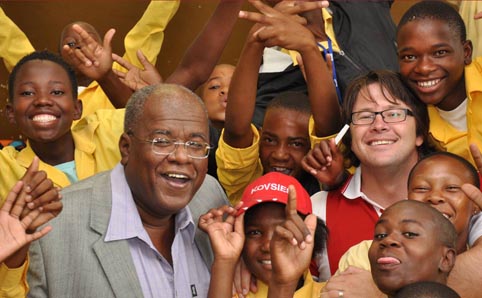 |
|
Prof. Jonathan Jansen, UFS Vice-Chancellor and Rector and Mr Rudi Buys, Dean: Student Affairs, with learners at the Bloemfontein-Oos Intermediary School.
Photo: Stephen Collett
|
The University of the Free State (UFS) has launched four exciting projects set out to improve the circumstances of its current and prospective students. These include a project that will honour dedicated and influential educators.
These community service projects in the starting blocks are: the UFS Schools Partnership Project, Extreme Make-over Project, Great Teachers Project and the No Student Hungry Campaign.
The Schools Partnership Project aims to support 21 schools across the Free State in helping them to become top achievers in the next three to five years. The schools involved were selected last year, after which the groundwork for the project was finalised. Although it mainly focuses on improving scholars' results in mathematics, accounting, physical sciences and English, it is also custom-designed according to the specific needs of the school, as indicated by the respective governing bodies beforehand. As a bonus, scholars of the schools involved will be given an opportunity to be introduced to student life; something Dr Choice Makhetha, UFS Vice-Rector: External Relations (acting), claimed to be of great importance. “We will invite Grade 10 to 12 learners to winter and summer schools being presented at the university. We will connect learners with students (one student adopts one learner for the day) for them to experience campus life. Grade 12 learners will also receive an invitation to the May 2011 graduation ceremony,” Dr Makhetha said.
Adding to the university's involvement at schools on local level, the newly upgraded Bloemfontein-Oos Intermediary School with its 112 UFS-sponsored tables will officially be revealed by the end of April. Although this school's upgrade showcases the power of partnerships, it is of special importance to the university, as it also marks the first school to receive an extreme make-over as part of the 'Extreme Make-over for Schools Project'. This project, in conjunction with the local business community, university staff and students, the community, the Department of Basic Education and SIFE (Students in Free Enterprise), is considered to be a flagship project of the Vice-Chancellor and Rector, Prof. Jonathan Jansen. Part of the project’s agreement includes visits from a group of about 100 students representing campus initiatives such as the UFS’s Kovscom, Rag and SIFE, which will contribute to the improvement of the schools' resources within a period of 10 – 15 weekends. “We invite support from all corners. South Africa has a business community committed to improving the social circumstances of its community and we plead that they also come to the rescue of the Bloemfontein-Oos Intermediary School,” said Dr Makhetha.
By spreading a 'can do' attitude, the UFS aims to honour noble and remarkable teachers across the country by means of its 'Great teacher's project'. Through the project, fellow citizens are encouraged to submit their stories on their former or current teachers’ dedication and their positive impact which are often overlooked. The panel of seasoned education scholars and practitioners will select the top 500 stories based on the stories' clarity, distinctiveness, plausibility and affectability, which will be perpetuated in a book called 'Great Teachers', to be released at the end of this year. Proceeds are destined to serve as bursaries for students who wish to pursue a career in education. According to Prof. Jansen the ideal teacher is: “Somebody who was among, but stood out above, their colleagues, a person who made a lasting impact long after the details of subject matter content of examination preparation were forgotten.”
Regardless of this exceptional effort of supporting schools across the province, the UFS remains committed to its students and their social welfare by means of the 'No student hungry' campaign. This project provides financially challenged students the opportunity to purchase food from the Thakaneng Bridge on the Main Campus in Bloemfontein by using their student cards at two selected kiosks serving balanced meals. The project, which is under the guardianship of Ms Grace Jansen and Dr Carin Buys, relies solely on several fund-raising projects across the country. These women are the respective spouses of the Rector and Dean: Student Affairs, Mr Rudi Buys. According to Ms Jansen this initiative was proposed after UFS staff reported that many students were struggling to concentrate on their studies due to hunger pangs. Although the campaign recognizes students with strong academic records, it doesn't overlook those who need a food bursary which might result in them dropping out. Ms Jansen said as the external funds gathered increase, so will the amount of students being supported by the project. “The plan is to continue until the fate of hungry students had come to an end,” she said.
Media Release
14 March 2011
Issued by: Lacea Loader
Director: Strategic Communication
Tel: 051 401 2584
Cell: 083 645 2454
E-mail: news@ufs.ac.za